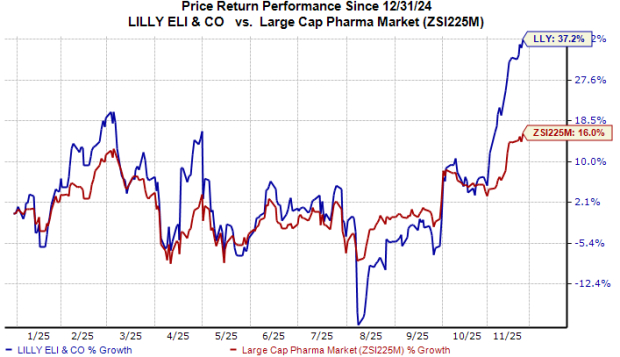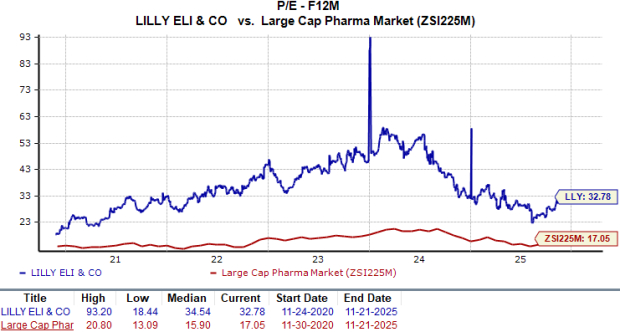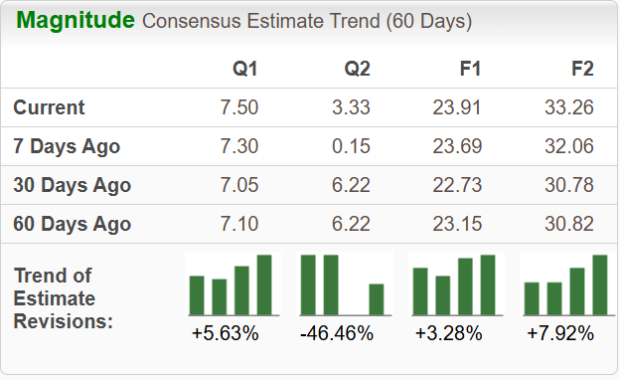|
|
|

|
|||||

|
|
Eli Lilly LLY secured a significant milestone on Friday when it became the first company in the healthcare space to reach $1 trillion in market value. With this breakthrough, Lilly is now the second non-tech company — and tenth overall in the United States — to join this exclusive club.
The key driver of achieving this 13-digit mark has been the success of its popular GLP-1 drugs — Mounjaro (for type II diabetes [T2D]) and Zepbound (for obesity) — that include the same compound, tirzepatide. Despite being on the market for about three years, both GLP-1 drugs have become major top-line drivers for the company.
Both Mounjaro and Zepbound have generated combined sales of nearly $25 billion in the first nine months of 2025, representing more than half of Lilly’s total revenues. Launches of Mounjaro and Zepbound in new international markets, along with improved supply from ramped-up production in the United States, have led to strong sales growth so far this year. We expect this positive trend to continue in 2026.
In the United States, Mounjaro is the market leader in new prescriptions within T2D incretin analogs, while Zepbound also holds a leading market share in the anti-obesity market.
Based on the strong momentum seen in the obesity space, Lilly has already started investing broadly in next-generation drugs and is currently developing a range of oral and injectable medications with different mechanisms of action. This includes two late-stage candidates, orforglipron, a once-daily oral GLP-1 small molecule, and retatrutide, a GGG tri-agonist, and some mid-stage candidates, bimagrumab, eloralintide and mazdutide. LLY remains on track to submit regulatory filings for orforglipron in obesity before this year’s end, setting up the timeline for a potential launch next year.
Beyond GLP-1 drugs, Lilly’s broader portfolio — including the oncology drug Verzenio and immunology drug Taltz — also continues to deliver steady growth. The company’s recently launched drugs, such as Omvoh and Ebglyss in immunology, Jaypirca in oncology and Kisunla in neuroscience, have all been contributing to its top-line growth.
To boost long-term growth and diversify beyond GLP-1 drugs, Lilly is seeking M&A deals across several therapeutic areas to expand its pipeline. Last month, it entered into a definitive agreement to acquire ophthalmology drugmaker Adverum Biotechnologies for a total deal value of under $300 million. LLY has already completed several M&A deals this year, which include the $1.3 billion acquisition of Verve Therapeutics,which added investigational gene therapies for heart disease and the $2.5 billion deal for Scorpion Therapeutics’ experimental oncology drug.
According to research conducted by Goldman Sachs, the obesity market in the United States is expected to reach $100 billion by 2030. Eli Lilly and Novo Nordisk NVO presently dominate this space.
Mounjaro and Zepbound directly compete with Novo Nordisk’s semaglutide medicines, Ozempic (for diabetes) and Wegovy (for obesity). Like Lilly, NVO also generates a substantial portion of its revenues from both drugs.
NVO and LLY are racing to introduce oral weight-loss pills. Novo Nordisk has already submitted a regulatory filing with the FDA seeking approval for an oral version of Wegovy, with a final decision expected before this year’s end. NVO is also developing several next-generation candidates in its obesity pipeline, including CagriSema (a combination of semaglutide and cagrilintide) and an oral pill, amycretin (a dual GLP-1 and amylin receptor agonist).
Several other companies, like Viking Therapeutics VKTX, are also making rapid progress in the obesity space. In June, VKTX started two late-stage studies evaluating the subcutaneous formulation of its investigational obesity drug, VK2735. While one of these studies recently completed enrolment at a rapid pace, the company expects to complete enrolment in the other study by the first quarter of 2026.
Earlier this month, Pfizer PFE closed the acquisition of obesity drug developer Metsera for around $10 billion, after a heated bidding war against Novo Nordisk. The Metsera acquisition has brought Pfizer back into the lucrative obesity space by adding the latter’s four novel clinical-stage incretin and amylin programs, which are expected to generate billions of dollars in peak sales.
Shares of Eli Lilly have outperformed the industry year to date, as seen in the chart below.

From a valuation standpoint, Eli Lilly is trading at a premium to the industry. Based on the price/earnings (P/E) ratio, the company’s shares currently trade at 32.78 times forward earnings, higher than its industry’s average of 17.05. The stock is also trading below its five-year mean of 34.54.

EPS estimates for 2025 and 2026 have increased in the past 30 days.

Eli Lilly currently carries a Zacks Rank #3 (Hold). You can see the complete list of today’s Zacks #1 Rank (Strong Buy) stocks here.
Want the latest recommendations from Zacks Investment Research? Today, you can download 7 Best Stocks for the Next 30 Days. Click to get this free report
This article originally published on Zacks Investment Research (zacks.com).
| 3 hours | |
| Dec-13 | |
| Dec-13 | |
| Dec-13 | |
| Dec-13 | |
| Dec-13 | |
| Dec-12 | |
| Dec-12 |
Eli Lilly Rises, Again, After EMA Groups Recommends Mounjaro For Children As Young As 10
LLY NVO
Investor's Business Daily
|
| Dec-12 | |
| Dec-12 | |
| Dec-12 | |
| Dec-12 | |
| Dec-12 | |
| Dec-12 | |
| Dec-12 |
Join thousands of traders who make more informed decisions with our premium features. Real-time quotes, advanced visualizations, backtesting, and much more.
Learn more about FINVIZ*Elite